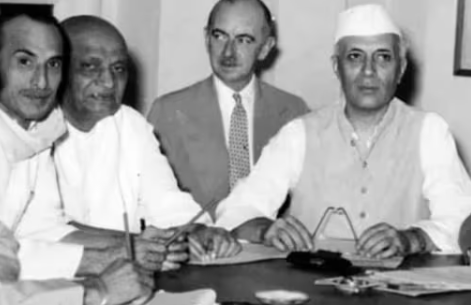When Nehru Told Wary Kashmiri Pandits To Attend The National Conference

A historic Bhairav temple in the center of Srinagar is Sheetalnath Bhairav Temple in Kralkhud. Prior to the Kashmiri Pandits’ 1990 seventh exodus as a result of ongoing slaughter, this temple and the expansive compound around it served as the focal point of their political expression.
On August 7, 1945, Jawaharlal Nehru addressed Kashmiri Pandit youth in this area of the temple compound when visiting Kashmir at the National Conference’s request.
The Indian National Congress stalwart gave strange counsel to Kashmir’s indigenous people, who had withstood Islamist oppression for 700 years and made up only 5% of Kashmir’s population at the time.
When speaking to the Pandit youth, Nehru declared that if non-Muslims wish to live in Kashmir, they should either join the National Conference or leave the nation. Even if not a single Hindu joins, the National Conference will still be considered the true national organization. No safeguards or weights will protect Pandits if they choose not to participate.
Nehru, a Kashmiri Pandit, was familiar with the history of the people of his ilk. Only under the Dogra kings had Kashmir’s Hindu population finally achieved relief and peace after a protracted period of repressive Islamic domination. Could Pandits be blamed for being suspicious of the revival of Islamic governance under Sheikh Abdullah’s leadership? Should they have had a meaningful response to their concerns?
Instead, Nehru advised the Pandits not to be communally oriented and to join the National Conference when they approached him to assist them in obtaining minority protection privileges. Pandits have frequently faced “Raliv, chaliv, galiv” (join, flee, or die) circumstances, hence it is astounding that Nehru would issue a warning that is comparable to an Islamist warning.
Much has been written about Maharaja Hari Singh and Nehru’s historic disagreement over their friendship with Sheikh Abdullah. Nehru wrongly believed Abdullah was a champion against imperialism and colonialism and that they shared many beliefs.
The reality is that Sheikh Abdullah’s policies were influenced by his personal resentments and disappointments, which he held the Dogra rulers accountable for. The goal of Abdullah’s overall political strategy was to overthrow Maharaja Hari Singh’s government and install Muslim control in Jammu and Kashmir. His pretense of secularism and friendship with Nehru was purely selfish and opportunistic.
Dr. Ramesh Taimiri, a renowned academic who has spent decades researching the history of contemporary Kashmir, claims that the British stopped entertaining Abdullah when Maharaja Hari Singh leased Gilgit to them in 1935. Because Jinnah never wanted another well-liked Muslim leader to threaten his authority, he could not stand Abdullah. Abdullah was forced to develop a friendship with Nehru.
Abdullah was astute enough to see that his vision of an independent Sheikhdom in Pakistan would never come true. He would become absorbed in the Muslim League’s bigger Muslim politics. He recognized in Nehru the possibility of establishing an autonomous Sheikhdom within India, and Nehru’s acceptance of Article 370 was the first step in that direction. a sovereign Indian state that is a state within a state, with its own flag, constitution, and prime minister. It was an impending train crash.
The myth that Maharaja Hari Singh delayed joining the Indian dominion because he was toying with the prospect of independence has also been perpetuated through time by establishment historians. There is no historical proof that Maharaja ever considered being independent. He was aware that choice was completely off the table. Princely states were offered the choice of joining Pakistan or India. There was nothing else to do.
With Sardar Patel, Maharaja had a line of communication open. On September 13, he even dispatched an ambassador to Delhi to convey his choice. Sheikh Abdullah, however, caused the Maharaja great concern. He was aware that Nehru would hand over control to Abdullah after he left office, and he did not want to do this.
The rehabilitation of Abdullah was the reason for the delay rather than the terms and conditions of accession. The entire process of joining India had been made to be somehow connected to Abdullah’s future by Nehru. Like every other princely state, that state’s king should have been in charge of deciding whether to join Pakistan or India. Only in Kashmir did Nehru make Abdullah and his rise to power the central theme.
Kashmir suffered catastrophic consequences as a result of the delay in ratifying the Instrument of Accession. As soon as Kashmir was established, Pakistan proclaimed jihad there. As part of Operation Gulmarg, Pakistani tribal militia massacred and wounded thousands of people before being stopped by the Indian Army.
On August 7, 1945, Nehru chastised Kashmiri Pandits in the vicinity of the Sheetalnath Bhairav temple. Their only transgression was that, as genocide survivors, they feared a restoration of majoritarian Islamic authority to Kashmir without any protections for minorities. Nehru treated their worries with disdain.
The seventh migration started in 1990, 45 years later. Pandits from Kashmir were once again left without a place to live. This time, several of them had given the future Indian prime minister plenty of notice. The Bhairav of the Sheetalnath temple is a living memorial to that occasion.
News Mania Desk






